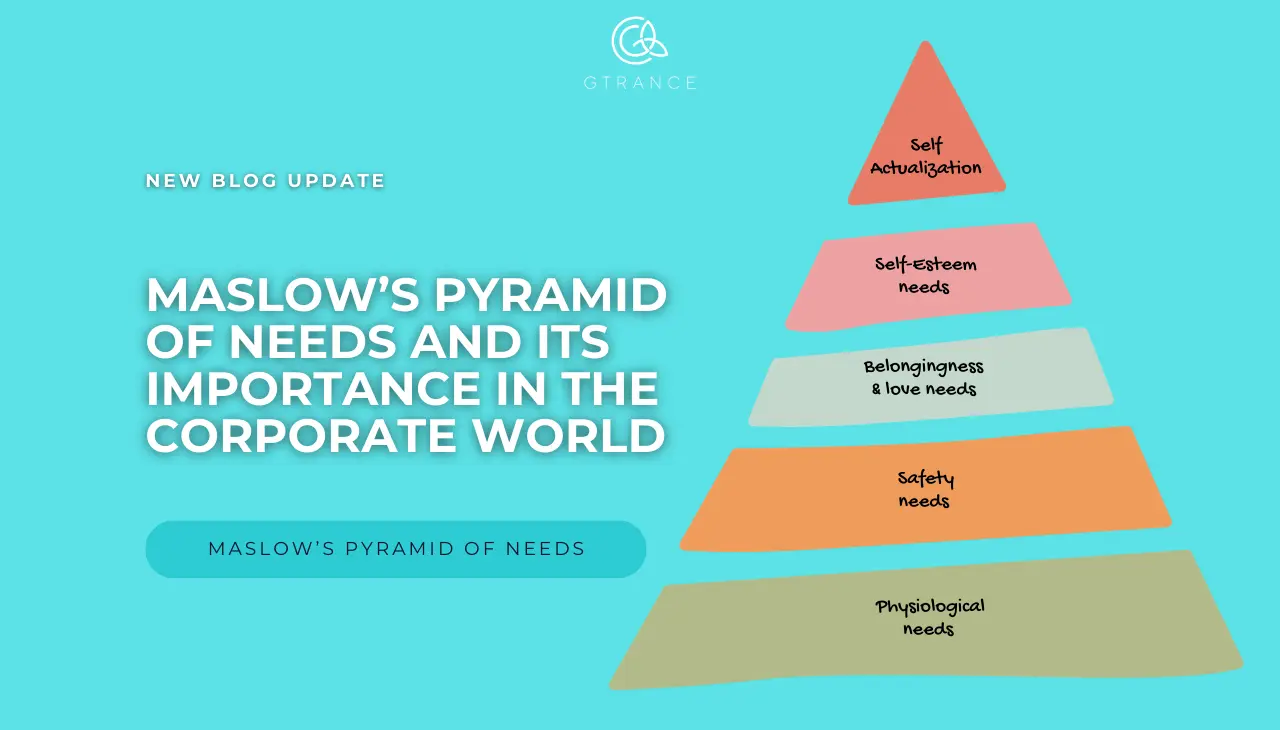
Maslow’s Pyramid of Needs, also known as Maslow’s Hierarchy of Needs, is a psychological theory proposed by Abraham Maslow in 1943. The theory is often depicted as a pyramid, with the most basic and fundamental needs at the bottom, and the more complex needs at the top. According to Maslow, human beings are motivated by the fulfillment of these needs, and they must satisfy lower-level needs before they can focus on higher-level ones.
Maslow’s Hierarchy of Needs (From Bottom to Top):
- Physiological Needs (Basic Needs):
These are the most basic survival needs, such as food, water, sleep, and shelter. In the workplace, this would equate to providing a safe and comfortable physical environment, a reasonable wage, and sufficient breaks. - Safety Needs (Security Needs):
Once physiological needs are met, individuals seek security and stability. This includes physical safety, financial security, job security, and health benefits. In the corporate world, this translates to stable employment, healthcare, retirement benefits, and a safe work environment. - Social Needs (Belongingness and Love):
Humans need to feel a sense of belonging, love, and connection with others. This includes friendships, relationships, and a sense of community. In the workplace, this is reflected in team collaboration, support from colleagues, and a positive company culture where employees feel included and valued. - Esteem Needs (Respect and Recognition):
After social needs are fulfilled, individuals seek recognition, respect, and a sense of achievement. This could be through job titles, promotions, praise, or other forms of acknowledgment. In the corporate world, this might involve employee recognition programs, opportunities for career advancement, and empowering employees with responsibilities that allow them to succeed. - Self-Actualization (Personal Growth):
This is the highest level of Maslow’s pyramid, where individuals strive to reach their full potential, seek personal growth, creativity, and self-fulfillment. In a corporate context, this means offering opportunities for employees to grow professionally and personally, whether through skill development, challenging projects, or leadership roles.
Applicability in the Corporate World:
Maslow’s Hierarchy of Needs can be highly relevant in shaping employee motivation and engagement within a business setting. Here’s how each level of the pyramid can apply to the corporate environment:
- Physiological Needs:
Workplace Environment: Ensure that employees have the basic comforts needed to work efficiently adequate lighting, heating, ventilation, ergonomic furniture, and a clean workspace.Fair Compensation: Offering salaries that allow employees to meet their basic needs, along with benefits such as paid time off, is essential for employee satisfaction. - Safety Needs:
Job Security: Providing employees with a sense of stability and long-term job security is crucial. This can be done by offering permanent contracts, transparent communication about the company’s financial health, and efforts to avoid layoffs.Health and Safety: Companies must maintain safe working conditions, both physically (e.g., safe machinery, emergency protocols) and psychologically (e.g., anti-harassment policies, and mental health support). - Social Needs:
Teamwork and Collaboration: Fostering an environment that promotes collaboration, communication, and mutual respect among employees helps to meet social needs. Social events, team-building activities, and mentorship programs can strengthen workplace relationships.Company Culture: Cultivating a culture where employees feel they belong, where diversity is valued, and where there is open communication helps meet employees’ social needs. - Esteem Needs:
Recognition and Rewards: Offering regular feedback, recognizing accomplishments, and providing rewards such as promotions, bonuses, or public acknowledgment can help fulfill employees’ esteem needs. Employees want to feel valued and respected for their work.Opportunities for Growth: Providing employees with opportunities to develop new skills, take on new challenges, and advance in their careers boosts their self-esteem. - Self-Actualization:
Personal Growth and Development: The highest level of Maslow’s hierarchy is about realizing one’s full potential. In the corporate world, this can be facilitated by providing employees with opportunities for professional development, leadership training, and challenging projects that allow them to use and develop their talents.Creative Freedom: Giving employees autonomy in how they approach their work and encouraging innovative thinking can help them achieve self-actualization. Companies that encourage creativity, continuous learning, and personal growth create an environment where employees can reach their highest potential.
Why Is Maslow’s Hierarchy of Needs Important in the Corporate World?
- Employee Motivation: Understanding that employees have different needs at various levels helps employers create policies and practices that cater to those needs, improving employee motivation, satisfaction, and retention.
- Employee Retention and Engagement: By fulfilling employees’ higher-level needs (esteem, self-actualization), companies can engage their workforce more effectively. Employees who feel respected, recognized, and empowered are more likely to stay long-term.
- Creating a Positive Work Environment: Maslow’s pyramid highlights the importance of a balanced approach to meeting employee needs. When employees’ basic needs are met, they are more likely to feel safe, supported, and motivated to contribute to the company’s success.
- Performance and Productivity: When employees’ needs are met at all levels, they are more likely to be engaged in their work and perform at a higher level. Employees who feel appreciated and empowered are more productive and innovative.
Example of Maslow’s Hierarchy Applied in the Workplace:
- Physiological: Providing a comfortable work environment, a living wage, and adequate rest time.
- Safety: Offering health insurance, job security, and a safe working environment.
- Social: Encouraging team-building events, collaborative work culture, and mentoring programs.
- Esteem: Recognizing employees through awards, promotions, and career development opportunities.
- Self-Actualization: Providing opportunities for creativity, leadership development, and learning new skills.
To sum it all up, Maslow’s Hierarchy of Needs is an important framework in the corporate world because it helps employers understand the different layers of employee needs and how to meet them. By addressing these needs, organizations can boost motivation, improve employee well-being, and create a positive work culture that enhances performance and retention. All this becomes more relevant in the presence of proper culture. Contact GTRANCE to understand how you can implement change management and such cultures within your organization.
©2025 Grace El Tayar